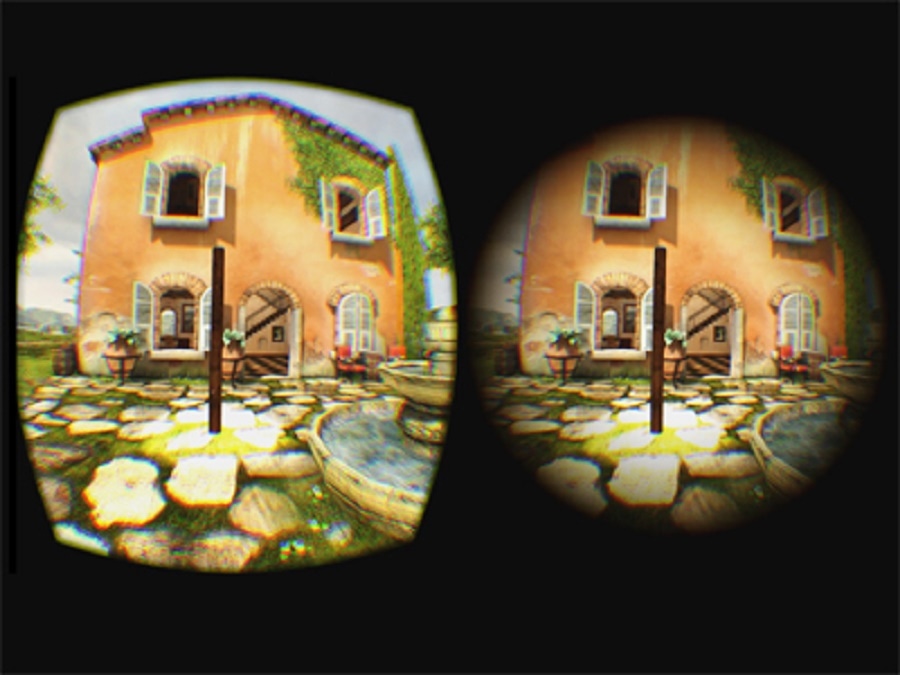Jun 16 2016
Steven K. Feiner, a Columbia Engineering Professor, and Ajoy Fernandes MS’16 have jointly invented a technique for fighting virtual reality (VR) sickness that can be used for consumer head-worn VR displays, such as Google Cardboard, HTC Vive, Oculus Rift, and Sony PlayStation VR. Their approach both slightly yet dynamically changes the user’s field of view (FOV) based on the visually perceived motion, as the user continues to be physically stable and yet virtually traverses an environment.
 Views of virtual environment before and after subtle dynamic field-of-view modification. Image courtesy of Ajoy Fernandes and Steve Feiner
Views of virtual environment before and after subtle dynamic field-of-view modification. Image courtesy of Ajoy Fernandes and Steve Feiner
The study highlighted that by automatically and strategically manipulating FOV, the VR sickness degree experienced by participants can be considerably reduced. The researchers achieved this without reducing the participants' sense of presence in the virtual environment, and also without most of the participants even being conscious of the intervention. The study was presented on March 20 at IEEE 3DUI 2016 (IEEE Symposium on 3D User Interfaces), where it also won the Best Paper Award.
2016 is the year of VR and it’s estimated that over 200 million VR headsets will be sold by 2020. But VR sickness, which has symptoms similar to motion sickness, poses a barrier for many users of this immersive technology. People who experience VR sickness will often stop using their headsets, as they feel nauseated and uncomfortable.
Steven K. Feiner, Engineering Professor, Columbia University
Fernandes and Feiner came up with an approach that dealt with the VR user’s FOV, changing it in a manner that a number of patients found hardly noticeable. “I was aware of work on change blindness—a concept in perceptual psychology that explains why people sometimes do not notice what would seem to be an obvious change in a scene,” explains Fernandes, who himself has suffered from VR sickness. “So I wondered if this could be applied to VR: could we change a participant’s FOV without them noticing?”
The researchers particularly concentrated on situations, where users move in the virtual environment in a manner that deliberately varies from the way they move in the real world. This includes games where they are physically sitting or standing on a couch place in their living room, while flying, driving, running, or walking in the virtual world. In these situations, the visual motion prompts, which users see, contradicts the physical motion prompts that they receive from the vestibular system of their inner ears, the prompts that provide individuals with their sense of motion, spatial orientation, and equilibrium. Users experience an uncomfortable and even nauseated feeling when the vestibular and visual cues conflict.
In a number of cases, these symptoms can be reduced by reducing the FOV. However, decreasing FOV also reduces the user's sense of presence in the virtual environment, making the experience less compelling.
Fernandes and Feiner concentrated on slightly reducing FOV in scenarios when a larger FOV would tend to cause VR sickness (when there is a mismatch between virtual and physical motion) and restoring it when there are less chances of the VR sickness to occur (when the mismatch reduces). The researchers developed a software that works as a pair of “dynamic FOV restrictors” with the potential to partially obscure the view of the eyes with a virtual soft-edged cutout. They further decided how much reduction is needed in the user's FOV, and the speed at which this reduction should be carried out and restored, and they then tested the system.
The team’s multi-day user study split 30 voluntary participants into two separate groups. One group investigated a VR environment that didn't have the dynamic FOV restrictors on the first day and included the restrictors on the second day. This order was changed for the second group. When the FOV restrictors were used by participants of the study, they felt even more comfortable and remained in the virtual environment for a longer time period than they did when the restrictors were not available. Two types of restrictors were utilized, where one was created to be more subtle than the other. The participants who used the restrictors, which were more subtle, did not notice them, and those who did notice them, stated that they would like to have them in upcoming VR experiences.
Fernandes and Feiner next plan to focus on how FOV restrictors could help users adapt to VR experiences. The researchers, for this study, used circular, soft-edged cutouts and now plan to conduct research using varied cutout textures and shapes. Fernandes and Feiner also aim at moving beyond their current area of interest, in which they decreased FOV as a simple function of angular velocity and speed, and made it possible to view the effect of decreasing FOV according to parameters such as optical flow or heart rate.
Virtual reality has the potential to profoundly change how we interact with people, machines, and information. It is critical that the experience be both comfortable and compelling, and we think we’ve found a way.
Steven K. Feiner, Engineering Professor, Columbia University
The team, headed by Feiner and Fernandes, has filed a provisional patent through Columbia Technology Ventures, included Luis Tolosa and Matthieu Gavaudan who helped organize and run the user study, and Carmine Elvezio and Mengu Sukan who provided suggestions and feedback.
The research was partially funded by the National Science Foundation under Grants IIS-0905569 and IIS-1514429.
Combating VR Sickness through Subtle Dynamic Field-Of-View Modification
Source: http://engineering.columbia.edu/